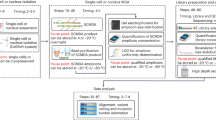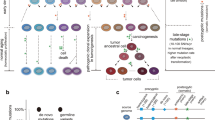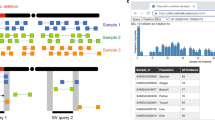Abstract
The dramatic increase in sequence information in the form of expressed sequence tags (ESTs)1 and genomic sequence has created a ‘gene function gap’, with the identification of new genes faroutpacing the rate at which their function can be identified. The ability to create mutations in embryonic stem (ES) cells on a large scale by tagged random mutagenesis provides a powerful approach for determining gene function in a mammalian system; this approach is well established in lower organisms2,3. Here we describe a high-throughput mutagenesis method based on gene trapping that allows the automated identification of sequence tags from the mutated genes. This method traps and mutates genes regardless of their expression status in ES cells. To facilitate the study of gene function on a large scale, we are using these techniques to create a library of ES cells called Omnibank, from which sequence-tagged mutations in 2,000 genes are described.
This is a preview of subscription content, access via your institution
Access options
Subscribe to this journal
Receive 51 print issues and online access
$199.00 per year
only $3.90 per issue
Buy this article
- Purchase on Springer Link
- Instant access to full article PDF
Prices may be subject to local taxes which are calculated during checkout




Similar content being viewed by others
References
Adams, M. D.et al. Complementary DNA sequencing: “Expressed sequence tags” and the Human Genome Project. Science 252, 1651–1656 (1991).
Plasterk, R. H. Reverse genetics of Caenorhabditis elegans. Bioessays 14, 629–633 (1992).
Spradling, A. C.et al. Gene disruptions using P transposable elements: an integral component of the Drosophila genome project. Proc. Natl Acad. Sci. USA 92, 10824–10830 (1995).
Gossler, A. & Zachgo, J. in Gene Targeting: A Practical Approach(ed. Joyner, A. L.) 181–227 (Oxford Univ. Press, New York, (1993).
Friedrich, G. & Soriano, P. Insertional mutagenesis by retroviruses and promoter traps in embryonic stem cells. Meth. Enzymol. 225, 681–701 (1993).
Chen, Z., Friedrich, G. A. & Soriano, P. Transcriptional enhancer factor 1 disruption by a retroviral gene trap leads to heart defects and embryonic lethality in mice. Genes Dev. 8, 2293–2301 (1994).
Zambrowicz, B. P.et al. Disruption of overlapping transcripts in the ROSA βgeo 26 gene trap strain leads to widespread expression of βgalactosidase in mouse embryos and hematopoietic cells. Proc. Natl Acad. Sci. USA 94, 3789–3794 (1997).
Townley, D. J., Avery, B. J., Rosen, B. & Skarnes, W. C. Rapid sequence analysis of gene trap integrations to generate a resource of insertional mutations in mice. Genome Res. 7, 293–298 (1997).
Hicks, G. G.et al. Functional genomics in mice by tagged sequence mutagenesis. Nature Genet. 16, 338–344 (1997).
Friedrich, G. & Soriano, P. Promoter traps in embryonic stem cells: a genetic screen to identify and mutate developmental genes in mice. Genes Dev. 5, 1513–1523 (1991).
Skarnes, W., Moss, J., Hurtley, S. & Beddington, R. Capturing genes encoding membrane and secreted proteins important for mouse development. Proc. Natl Acad. Sci. USA 92, 6592–6596 (1995).
Altschul, S. F., Gish, W., Miller, W., Meyers, E. W. & Lipman, D. J. Basic local alignment search tool. J. Mol. Biol. 215, 403–410 (1990).
Oeltjen, J. C.et al. Large-scale comparative sequence analysis of the human murine Bruton's tyrosine kinase loci reveals conserved regulatory domains. Genome Res. 7, 315–329 (1997).
de Weers, M.et al. The Bruton's tyrosine kinase gene is expressed throughout B cell differentiation, from early precursor B cell stages preceding immunoglobulin gene rearrangement up to mature B cell stages. Eur. J. Immunol. 23, 3109–3114 (1993).
Chang, W., Hubbard, C., Friedel, C. & Ruley, E. Enrichment of insertional mutants following retrovirus gene trap selection. Virology 193, 737–747 (1993).
Withers-Ward, E. S., Kitamura, Y., Barnes, J. P. & Coffin, J. M. Distribution of targets for avian retrovirus DNA integration in vivo. Genes Dev. 8, 1473–1487 (1994).
Craigie, R. Hotspots and warm spots: integration specificity of retroelements. Trends Genet. 8, 187–190 (1992).
Soriano, P., Friedrich, G. & Lawinger, P. Promoter interaction in retrovirus vectors introduced into fibroblasts and embryonic stem cells. J. Virol. 65, 2314–2319 (1991).
Zhu, B., Bogue, M. A., Lim, D.-S., Hasty, P. & Roth, D. B. Ku86-deficient mice exhibit severe combined immunodeficiency and defective processing of V(D)J recombination intermediates. Cell 86, 379–389 (1996).
Hasty, P., Rivera-Perez, J., Chang, C. & Bradley, A. Target frequency and integration pattern for insertion and replacement vectors in embryonic stem cells. Mol. Cell. Biol. 11, 4509–4517 (1991).
Acknowledgements
We thank A. Bradley for ideas; M. Brandt, J. Fitzgibbons, C. Mossel, M. Newhouse, D. Potter and T. Smith for technical assistance; J. D. Wallace and A. Benjamin for tissue culture; D. Becer, L. Grocki, D. Leibham, T. Malley and S. Patel for automation and sequencing; B. Kohlhauf for computer support; and P. Hasty, R. Burgess, A. Turner and M. Nehls for discussion.
Author information
Authors and Affiliations
Supplementary information
Supplementary Information
Supplementary Information
Supplementary Information
Rights and permissions
About this article
Cite this article
Zambrowicz, B., Friedrich, G., Buxton, E. et al. Disruption and sequence identification of 2,000 genes in mouse embryonic stem cells. Nature 392, 608–611 (1998). https://doi.org/10.1038/33423
Received:
Accepted:
Issue Date:
DOI: https://doi.org/10.1038/33423
This article is cited by
-
The cofilin phosphatase slingshot homolog 1 restrains angiotensin II-induced vascular hypertrophy and fibrosis in vivo
Laboratory Investigation (2019)
-
Loss-of-function genetic tools for animal models: cross-species and cross-platform differences
Nature Reviews Genetics (2017)
-
Deficiency of COX7RP, a mitochondrial supercomplex assembly promoting factor, lowers blood glucose level in mice
Scientific Reports (2017)
-
Adiponectin receptor 1 conserves docosahexaenoic acid and promotes photoreceptor cell survival
Nature Communications (2015)
-
A stabilizing factor for mitochondrial respiratory supercomplex assembly regulates energy metabolism in muscle
Nature Communications (2013)
Comments
By submitting a comment you agree to abide by our Terms and Community Guidelines. If you find something abusive or that does not comply with our terms or guidelines please flag it as inappropriate.



